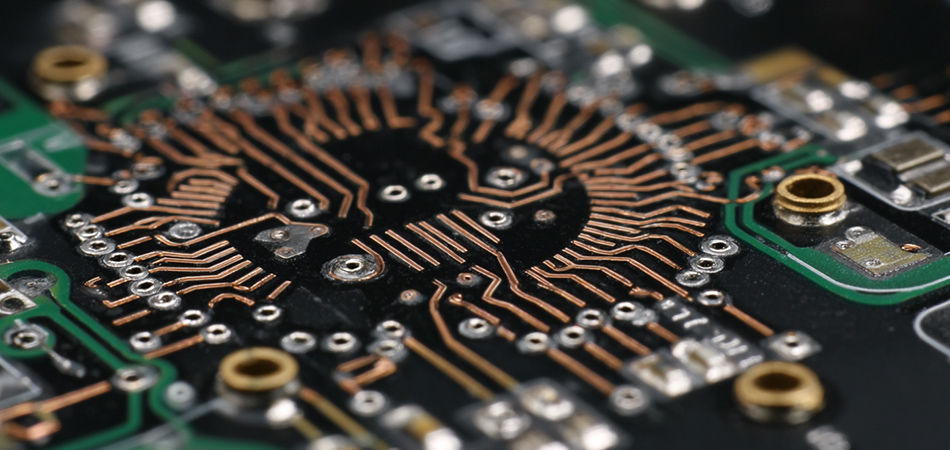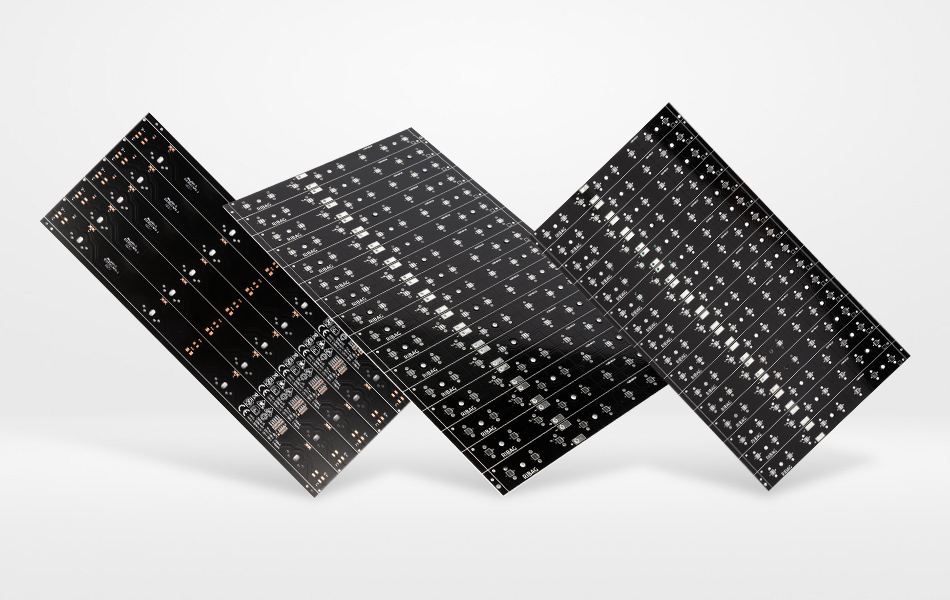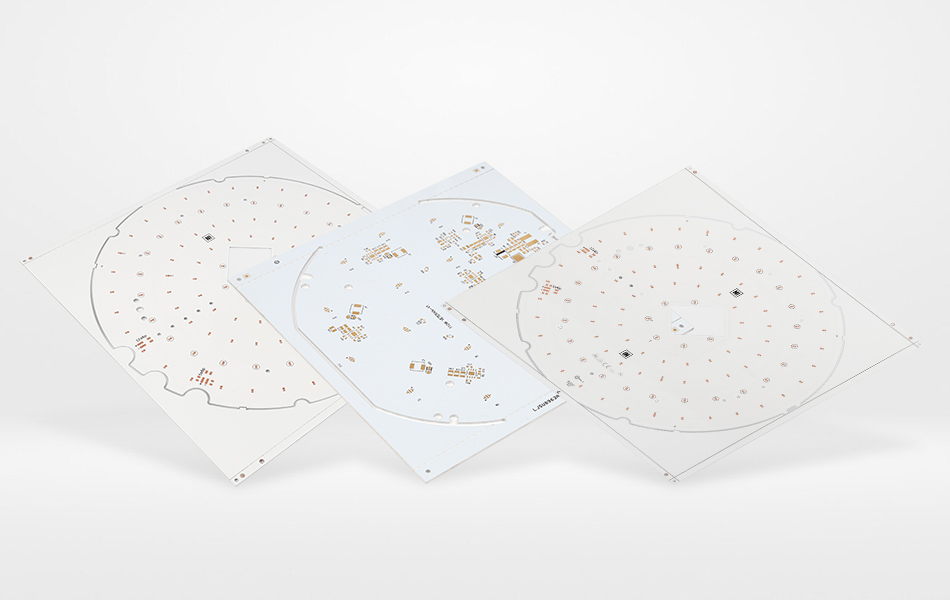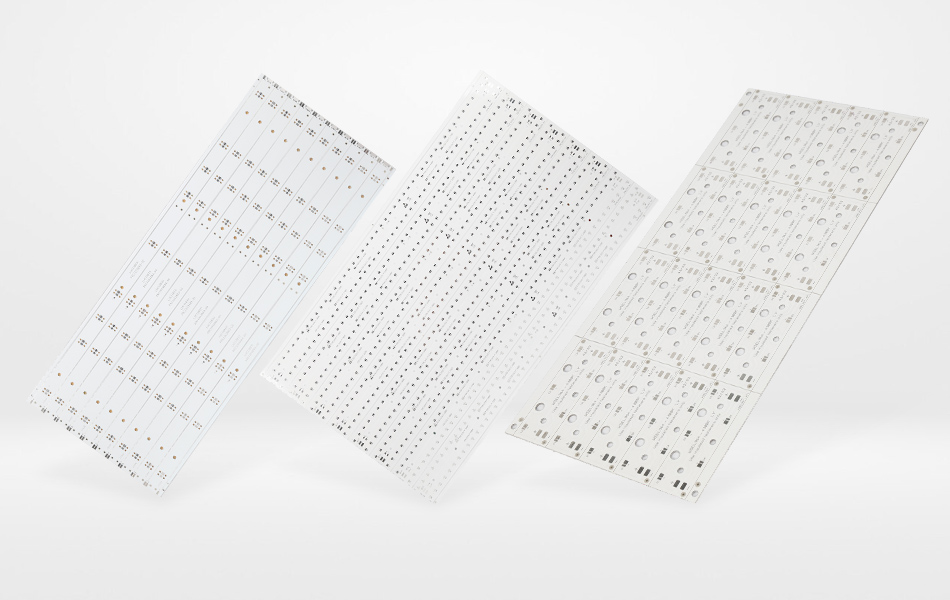-
- PCB TYPE
- PRINTED CIRCUIT BOARD PROTOTYPE ALUMINUM PRINTED CIRCUIT BOARD R&F PCB FPC HIGH FREQUENCY PCB HIGH-TG PCB HEAVY COPPER PCB HDI PCB PCB FOR LIGHTING METAL CORE PCB
time:Jun 27. 2025, 08:07:15
In the dynamic realm of printed circuit board (PCB) technology, aluminum PCBs have emerged as a preferred choice for numerous applications, owing to their exceptional thermal conductivity and mechanical robustness. Among the various features that contribute to the functionality and reliability of these boards, counterbore holes play a crucial role. A counterbore hole, in the context of PCBs, is a special type of hole that has a wider diameter at the bottom compared to the opening. This article focuses specifically on the 3mm diameter counterbore in aluminum PCBs, delving into its design considerations, manufacturing processes, quality control aspects, and applications across different industries.
Design Considerations for 3mm Diameter Counterbore in Aluminum PCBs
Function and Significance of Counterbore Holes
Counterbore holes in aluminum PCBs serve multiple essential functions. One primary function is to accommodate fasteners such as screws or rivets in a way that ensures a flush - mounted connection. When using flat - head screws, the counterbore hole allows the screw head to sit below the surface of the PCB. This not only provides a more aesthetically pleasing finish but also has practical implications. It helps in reducing the overall height of the assembled components, which is crucial in applications where space is at a premium, such as in portable electronics or aerospace systems.
In addition, a well - designed counterbore hole distributes the clamping force more evenly when a fastener is tightened. This reduces the risk of stress concentrations around the hole, which could potentially lead to cracks or fractures in the PCB over time, especially in high - vibration environments. For 3mm diameter counterbore holes, these functions are tailored to the specific requirements of the components and the overall PCB design.
Compatibility with Components and Fasteners
When designing a 3mm diameter counterbore in an aluminum PCB, it is vital to ensure compatibility with the components and fasteners that will be used. The diameter of the counterbore should be precisely matched to the head diameter of the fastener. For example, if a particular flat - head screw has a head diameter that is optimally accommodated in a 3mm counterbore, any deviation from this size could result in a loose or tight fit. A loose fit may cause the fastener to move within the hole, leading to unreliable connections and potential mechanical failures. On the other hand, a tight fit could make it difficult to insert the fastener, and in extreme cases, may damage the PCB during installation.
The depth of the counterbore also needs to be carefully considered. It should be sufficient to fully recess the head of the fastener, but not so deep that it compromises the structural integrity of the PCB. In the case of a 3mm diameter counterbore, the depth is determined based on the thickness of the aluminum substrate, the type of fastener, and the overall design requirements of the PCB.
Placement on the PCB
The placement of 3mm diameter counterbore holes on the aluminum PCB is a critical aspect of the design process. From a mechanical perspective, the holes should be located in areas that can withstand the forces exerted by the fasteners. This means avoiding regions near the edges of the PCB where the material may be more prone to stress - induced failures. Additionally, it is important to consider the proximity of the counterbore holes to other components on the board. Placing a counterbore hole too close to a sensitive electronic component, such as an integrated circuit or a capacitor, could lead to interference or damage during the fastening process.
Electrical considerations also come into play when determining the placement of counterbore holes. The holes should not be located in areas where they could potentially short - circuit electrical traces on the PCB. Adequate clearance between the counterbore hole and the copper traces needs to be maintained to ensure the proper functioning of the electrical circuits. In complex PCB designs, computer - aided design (CAD) software is often used to optimize the placement of 3mm diameter counterbore holes, taking into account both mechanical and electrical requirements.

Manufacturing Processes for 3mm Diameter Counterbore in Aluminum PCBs
Drilling the Initial Hole
The manufacturing process of creating a 3mm diameter counterbore in an aluminum PCB begins with drilling the initial hole. High - precision drilling machines are employed for this task. These machines are equipped with advanced control systems that ensure accurate hole placement and consistent hole diameters. When drilling aluminum PCBs, specialized drill bits are used. These bits are typically made of high - speed steel or carbide, which can withstand the high temperatures generated during the drilling process and provide clean, burr - free holes.
For a 3mm diameter initial hole, the drill bit size is carefully selected to achieve the desired diameter within tight tolerances. The drilling speed and feed rate are also optimized to balance the need for efficient material removal with the prevention of overheating and damage to the aluminum substrate. In some cases, coolant may be used during the drilling process to dissipate heat and improve the quality of the hole.
Creating the Counterbore
After the initial 3mm hole is drilled, the counterbore is created. There are several methods available for this step. One common method is mechanical counterboring, which involves using a counterboring tool. This tool is a specialized bit with a cylindrical cutting edge that is larger in diameter than the initial hole. As the counterboring tool rotates, it removes material from the top of the drilled hole, creating the wider, recessed portion of the counterbore.
The speed and feed rate of the counterboring tool are carefully controlled to ensure a smooth and accurate counterbore with the desired depth and diameter. In some cases, especially for high - volume production, automated machinery may be used to perform the counterboring operation, providing greater consistency and efficiency. Another method for creating a counterbore is through the use of computer - numerical - control (CNC) machining. CNC machines can be programmed to precisely control the movement of the cutting tool, allowing for the creation of complex counterbore shapes and sizes, including the 3mm diameter counterbore.
Post - Processing and Quality Assurance
Once the counterbore hole has been created, post - processing steps are often necessary to ensure its quality. Deburring is a crucial post - processing operation. Burrs are small, sharp protrusions of material that are left behind during the drilling and counterboring processes. These burrs can interfere with the proper seating of the fastener and may also pose a risk to the electrical insulation of the PCB. Deburring can be done manually using tools such as files or deburring brushes, or it can be automated using specialized deburring machines.
Quality assurance is an integral part of the manufacturing process. Inspections are carried out to check the dimensions, shape, and surface finish of the 3mm diameter counterbore holes. Precision measuring instruments, such as calipers, micrometers, and coordinate - measuring machines (CMMs), are used to verify that the holes meet the specified design requirements. Visual inspections are also conducted to look for any visible defects, such as cracks or uneven surfaces. In some cases, non - destructive testing methods, such as X - ray inspection, may be used to detect internal defects that are not visible to the naked eye.

Quality Control of 3mm Diameter Counterbore in Aluminum PCBs
Dimensional Inspection
Dimensional inspection is a key aspect of quality control for 3mm diameter counterbore holes in aluminum PCBs. The diameter of the initial hole, the diameter of the counterbore, and the depth of the counterbore are all measured using highly accurate instruments. CMMs are particularly useful for this purpose as they can provide three - dimensional measurements with sub - millimeter precision.
Any deviation from the specified dimensions can have a significant impact on the performance of the PCB assembly. For example, an incorrectly sized counterbore diameter may result in a loose or tight fit for the fastener, affecting the mechanical and electrical integrity of the connection. The depth of the counterbore, if not within the specified tolerance, can either leave the fastener head protruding or cause the hole to be too deep, weakening the PCB structure.
Visual Inspection
Visual inspection is another important quality control measure. Trained inspectors carefully examine the 3mm diameter counterbore holes for any visible defects. Burrs, as mentioned earlier, are a common defect that can be detected through visual inspection. Cracks in the aluminum substrate around the counterbore hole are also a concern, as they can compromise the structural integrity of the PCB. Uneven surfaces or rough finishes on the counterbore can also affect the proper seating of the fastener.
Automated optical inspection (AOI) systems can be used to enhance the efficiency and accuracy of visual inspections. These systems use cameras and image - processing algorithms to detect even the smallest defects. AOI systems can be programmed to recognize specific defect patterns and provide real - time feedback during the manufacturing process, allowing for immediate corrective action.
Functional Testing
In addition to dimensional and visual inspections, functional testing may be carried out to ensure that the 3mm diameter counterbore holes do not negatively impact the electrical and mechanical functionality of the PCB. Mechanical functional tests can involve applying simulated forces to the fastened components to check the strength and stability of the connection. For example, a pull - out test may be performed to determine the force required to remove a screw from the counterbore hole.
Electrical functional tests can include continuity testing, insulation resistance testing, and signal integrity testing. These tests help to verify that the counterbore holes have not caused any electrical problems, such as short - circuits or increased electrical resistance. In applications where the fastener also serves as an electrical conductor, proper electrical contact through the counterbore hole is essential for the reliable operation of the electronic system.

Applications of 3mm Diameter Counterbore in Aluminum PCBs
Automotive Electronics
In the automotive industry, 3mm diameter counterbore holes in aluminum PCBs find extensive use. In engine control units (ECUs), which are responsible for managing various engine functions, components need to be mounted securely to withstand the harsh operating conditions of an engine compartment, including high temperatures, vibrations, and electrical noise. The 3mm diameter counterbore holes are used to attach components such as sensors, actuators, and power modules to the aluminum PCB. The flush - mounted connections provided by the counterbore holes help in reducing the overall size of the ECU, allowing for more compact and efficient packaging.
In automotive lighting systems, such as LED headlights, aluminum PCBs with 3mm diameter counterbore holes are used to mount the LED components. The counterbore holes ensure a stable mechanical connection and also facilitate efficient heat transfer from the LEDs to the aluminum substrate, which is crucial for the long - term performance and lifespan of the LEDs.
Aerospace and Defense
The aerospace and defense sectors rely heavily on high - reliability electronic systems. In avionics systems, which are used for navigation, communication, and control in aircraft, aluminum PCBs with 3mm diameter counterbore holes are employed to mount critical components. The ability of the counterbore holes to provide a secure and flush - mounted connection is essential in this industry, as any component movement or failure could have catastrophic consequences.
In defense applications, such as missile guidance systems and radar systems, the use of 3mm diameter counterbore holes in aluminum PCBs helps to ensure the integrity of the electronic assembly in harsh and demanding environments. The mechanical strength and reliability provided by the counterbore - fastened components are vital for the proper functioning of these systems in combat and extreme weather conditions.
Consumer Electronics
Consumer electronics, such as smartphones, tablets, and laptops, also benefit from the use of 3mm diameter counterbore holes in aluminum PCBs. In these devices, space is at a premium, and a compact and lightweight design is highly desirable. The counterbore holes are used to mount internal components, such as batteries, circuit boards, and display modules. The flush - mounted connections not only save space but also contribute to the sleek and aesthetically pleasing design of the consumer electronics products.
For example, in a smartphone, the battery may be attached to the aluminum PCB using screws that fit into 3mm diameter counterbore holes. This provides a secure connection while minimizing the overall thickness of the device. In addition, the reliable mechanical and electrical connections provided by the counterbore - fastened components help to improve the durability and performance of consumer electronics products.

Future Trends and Challenges
Miniaturization and Higher Density
As the electronics industry continues to trend towards miniaturization and higher component density, the demand for smaller and more precisely manufactured 3mm diameter counterbore holes in aluminum PCBs is likely to increase. With the development of smaller and more powerful electronic components, PCBs need to be designed to accommodate these components in a more compact manner. This will require the use of advanced manufacturing techniques and technologies to achieve even tighter tolerances in the creation of counterbore holes.
Manufacturers will need to invest in research and development to develop new tools and processes that can create 3mm diameter counterbore holes with greater precision and efficiency. This may involve the use of advanced micro - machining technologies, such as laser - assisted machining or electron - beam machining, which can offer higher levels of precision compared to traditional mechanical methods.
Integration of New Materials and Technologies
The integration of new materials into aluminum PCBs, such as advanced composites and nanomaterials, may present new challenges and opportunities for the manufacturing and use of 3mm diameter counterbore holes. These new materials may have different mechanical and electrical properties, requiring adjustments to the traditional manufacturing processes for counterbore holes.
For example, if a new type of aluminum - based composite material is used in PCBs, the drilling and counterboring processes may need to be optimized to account for the material's unique characteristics. Additionally, emerging technologies, such as 3D printing for PCBs, could potentially revolutionize the way 3mm diameter counterbore holes are created. However, this would also require the development of new design and manufacturing strategies to ensure the quality and reliability of the counterbore holes in 3D - printed PCBs.
Environmental Sustainability
Increasing concerns about environmental sustainability are driving the electronics manufacturing industry to adopt more eco - friendly practices. This includes the development of manufacturing processes for 3mm diameter counterbore holes in aluminum PCBs that reduce the use of hazardous chemicals and minimize waste generation.
Manufacturers will need to explore alternative materials and processes that are more environmentally friendly while still maintaining the high - quality standards required for these holes. Recycling and proper disposal of PCBs at the end of their life cycle will also become increasingly important considerations. The industry may need to develop new recycling methods that can effectively separate and reuse the materials from PCBs with 3mm diameter counterbore holes, reducing the environmental impact of electronic waste.

Conclusion
The 3mm diameter counterbore in aluminum PCBs is a crucial feature that plays a significant role in ensuring the functionality, reliability, and aesthetics of PCB assemblies. Through careful design, precise manufacturing, and rigorous quality control, these counterbore holes are tailored to meet the diverse requirements of various industries, including automotive, aerospace, defense, and consumer electronics.
As the electronics industry continues to evolve, the 3mm diameter counterbore in aluminum PCBs will face new challenges and opportunities. The trends towards miniaturization, the integration of new materials and technologies, and the focus on environmental sustainability will drive the development of new and improved solutions for creating and using these counterbore holes. By staying at the forefront of innovation and addressing these challenges, the electronics manufacturing industry can continue to leverage the benefits of 3mm diameter counterbore holes in aluminum PCBs to create advanced and reliable electronic devices.

Got project ready to assembly? Contact us: info@apollopcb.com



We're not around but we still want to hear from you! Leave us a note:

Leave Message to APOLLOPCB
